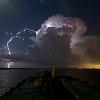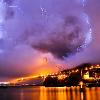

Even as the search for debris of Air France Flight 447 intensifies the deeper quest for answers continues What caused an experienced pilot and a top line jet to crash into the Atlantic Tags: Thunderstorm View |
Ok not quite an innovation storm but it s kinda cool to imagine that with all the awesome thinking going on in this wonderful part of the world that there would be a few brainsparks from Tags: Thunderstorm View |
Tags: Thunderstorm View |
|||||||||
Tags: Thunderstorm View |
thunderstorm, also known as an electrical storm, a lightning storm, thundershower or simply a storm is a form of weather characterized by the presence of lightning and its acoustic (acoustics) effect on the Earths atmosphere known as thunder. The meteorologically-assigned cloud type associated with the thunderstorm is the cumulonimbus. Thunderstorms are usually accompanied by strong winds (Wind), heavy rain (heavy rain (meteorology)) and sometimes snow (Thundersnow), hail, or no precipitation (Dry thunderstorm) at all. Those which cause hail to fall are known as hailstorms. Thunderstorms may line up in a series (thunderstorm training) or rainband, known as a squall line. Strong or severe thunderstorms may rotate, known as supercells. While most thunderstorms move with the mean wind flow through the layer of the troposphere that they occupy, vertical wind shear causes a deviation in their course at a right angle to the wind shear direction. Thunderstorms result from the rapid upward movement of warm, moist air. They can occur inside warm, moist air masses and at fronts. As the warm, moist air moves upward, its cools, condenses, and forms cumulonimbus clouds that can reach heights of 10 km. As the rising air reaches its dew point, water droplets and ice form and begin falling the long distance through the clouds towards Earths surface. As the droplets fall, they collide with other droplets and become larger. The falling droplets create a downdraft of air that spreads out at Earths surface and causes strong winds associated with thunderstorms.
Thunderstorms can generally form and develop in any geographic location, perhaps most frequently within areas located at mid-latitude (Mid-latitudes) when warm moist air collides with cooler air. Thunderstorms are responsible for the development and formation of many severe weather phenomena. Thunderstorms, and the phenomena that occur along with them, pose great hazards to populations and landscapes. Damages that result from thunderstorms are mainly inflicted by downburst winds, large hailstones, and flash flooding caused by heavy precipitation (precipitation (meteorology)). Stronger thunderstorm cells are capable of producing tornadoes and waterspouts. Weather There are four types of thunderstorms: single-cell, multicell cluster, multicell lines, and supercells. Supercell thunderstorms are the strongest and the most associated with severe weather phenomena. Mesoscale convective systems formed by favorable vertical wind shear within the tropics and subtropics are responsible for the development of hurricane (Tropical cyclone)s. Dry thunderstorms, with no precipitation, can cause the outbreak of wildfires with the heat generated from the cloud-to-ground lightning (Lightning#Cloud-to-ground lightning) that accompanies them. Several methods are used to study thunderstorms, such as weather radar, weather stations, and video photography. Past civilizations held various myths concerning thunderstorms and their development as late as the Eighteenth Century. Other than within the Earths atmosphere, thunderstorms have also been observed on Jupiter and Venus.




